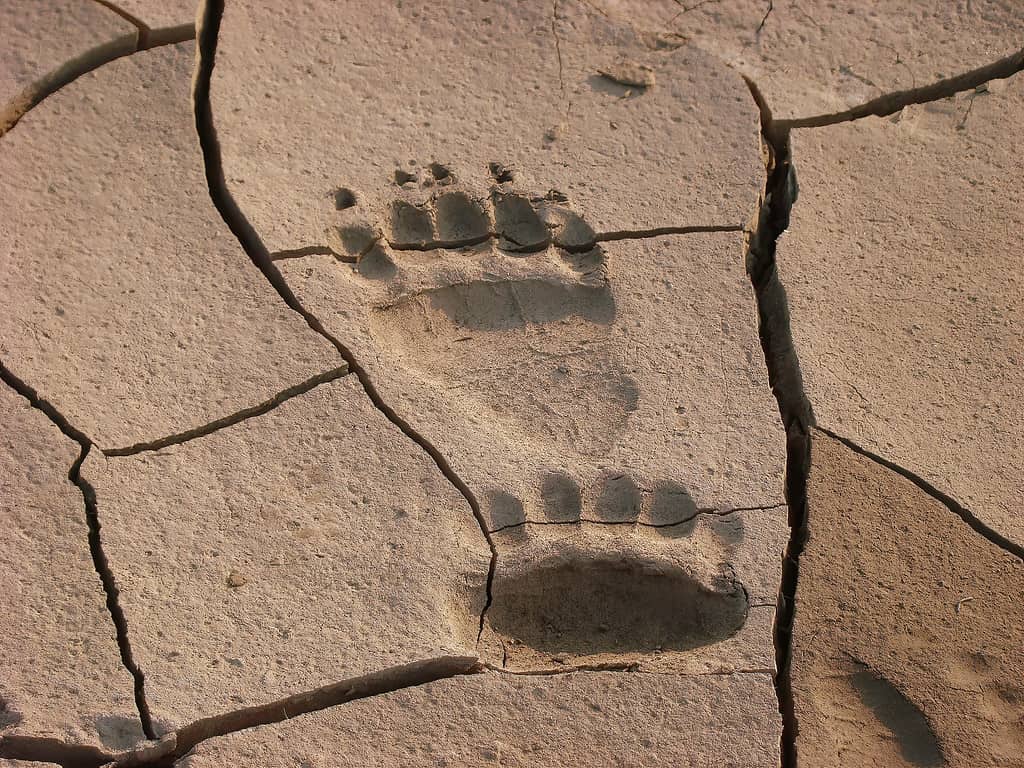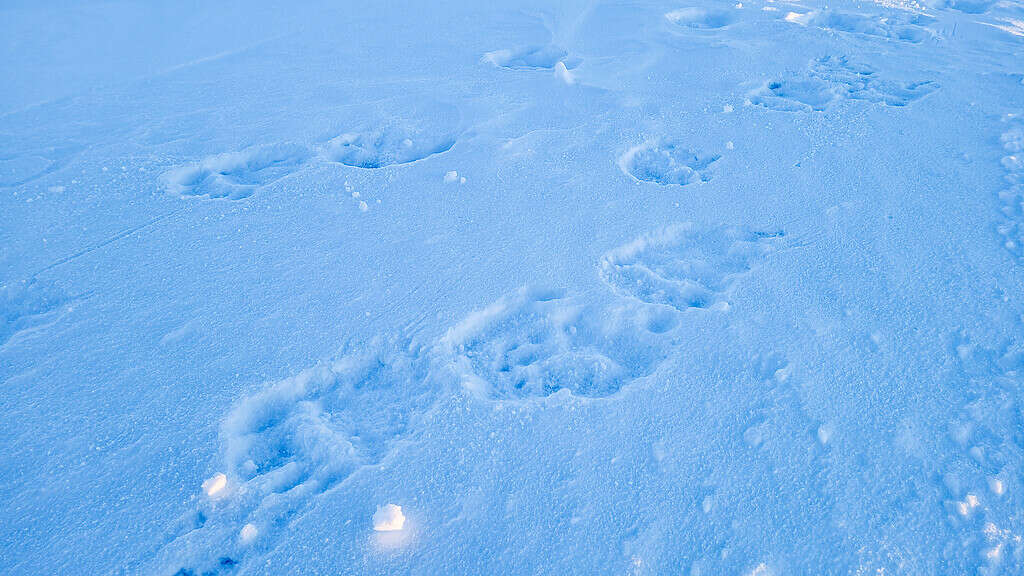If you ever go to a natural habitat full of non-human animals, you’ll see different types of footprints or tracks. Trying to figure out what animal created any given set of tracks can be quite interesting. But, more importantly, it’s good to know what types of animals are around you so that you have some idea of your safety in that location. Bears can certainly be dangerous to humans under certain circumstances. Some species are more dangerous than others. This is why if you see bear tracks, it’s good to know what types of bears produced them. Read on to learn more about bear tracks!
Bear Tracks: General Information
Bears often do not leave distinct tracks unless they are walking through soft surfaces, such as wet mud or snow. This is because they have soft feet and generally walk on their soles.
These animals have five toes on each foot. The large toe is on the outside; the inner toe is often the smallest and doesn’t always appear in the tracks. This is because bears tend to walk with the majority of their weight on the outer part of their foot.
Their footpads are larger at the outer edges, with their front tracks being wider than the rear ones. However, the rear tracks are usually longer than the front ones. This is because the small round heel pad of the bear’s front foot usually does not register on the walking surface. They do dig their rear heels into the mud, which is why those tracks are longer.
Sometimes, bear tracks can be deceiving. It is common for them to travel in an overstep walk, where their rear foot plants into the ground just slightly in front of where the front foot just did. This results in the appearance of a double track, which can make the bear tracks look much bigger than they actually are.
Even though bears will walk on forest roads and deer trails, there are some trails that are exclusively used by bears. On these trails, humans can see a series of depressions. These are where multiple bears set their feet on the ground in the exact same areas for long periods of time.
When bears approach their favorite marking trees, they tend to stomp-walk. Experts can see in the ground that they have stomped, twisted, and slid each of their footsteps at these locations.
Grizzly Bear Tracks
Grizzly bears can be found in certain areas of the United States and Canada. There are grizzly bear populations in Montana, Washington, Wyoming, Idaho, and Alaska.
Grizzly bear tracks will display a semi-squared foot pad. There is space between the toes and the foot pad. These bears also have fairly long claws, between 2 and 4 inches long. The claws may puncture the ground, but only slightly. The curve of the claws is even and gentle.
Front tracks are typically 5 inches wide and 7 inches long. Hind tracks are 6 inches wide and 11 inches long.

Grizzly bear tracks will display a semi-squared foot pad.
©John charles hansen/Shutterstock.com
| Size | Shape |
| Front tracks – 5 inches wide, 7 inches long | Semi-squared foot pad |
| Hind tracks – 6 inches wide, 11 inches long | Space between toes and foot pad |
| Long claws that do not sharply puncture the ground |
American Black Bear Tracks
North American black bears tend to roam quite a bit. Their territories can be very large as a result. They typically reside in the northwest United States, although black bears can be found all over the continental United States. There are also black bears throughout Canada and in northern Mexico. These bears are the most common in North America.
In black bear tracks, you will see five toes and a round foot pad. Each toe has a short claw, close to the toe. Usually, the claws are about 1.5 inches long. The claws puncture the ground with their sharp curves.
The tracks of black bears’ hind feet are about 3.5 to 4 inches wide and 7 inches long. Front foot tracks are about 3 to 4 inches wide and 4 inches long.

In black bear tracks, you will see five toes and a round foot pad.
©Ryley MacKinnon/Shutterstock.com
| Size | Shape |
| Front tracks – 3-4 inches wide, 4 inches long | Round foot pad |
| Hind tracks – 3.5-4 inches wide, 7 inches long | Short claws that sharply puncture the ground |
Polar Bear Tracks
Polar bears are by far the largest bears in North America. They live in the arctic areas of Canada and northern Alaska. Because of the environments in which they live, you will usually only see polar bear tracks in the snow.
Polar bear tracks are quite large. The front paws are 9 inches wide and 5.5 inches long. Their rear paws are even larger, up to 9 inches wide and 13 inches long.
The size of these tracks is how you can fairly easily distinguish them from those of other bears. If they happen to be walking through mud, you can still tell them apart by their size. Additionally, you will see brush marks. The reason for this is that the paw of the polar bear is entirely covered in hair.
The claws of these bears rarely register in tracks, as they are diminutive in size and fairly stubby.

Polar bear tracks are quite large, as polar bears are the largest bears in North America.
©Derek Robbins/Shutterstock.com
| Size | Shape |
| Front tracks – 9 inches wide, 5.5 inches long | Brush marks due to the hair covering the paws |
| Hind tracks – 9 inches wide, 13 inches long | Short, stubby claws that usually do not puncture the ground |
Ways to Distinguish Between Bears Based on Tracks
If you want to be able to tell what kind of bear was recently in the area, there are ways to tell bear tracks apart.
The tracks of polar bears can be distinguished from the others based on their size alone. The brush marks from their fur are also a distinguishing factor. Additionally, they generally live in much colder areas, and their habitats do not usually overlap with those of black bears and grizzly bears.
There may be some confusion between the tracks of black and grizzly bears, as there is some overlap in their habitats. The US Fish and Wildlife Service advises people to draw a straight line in the ground from the left to right toe. If this line crosses the footpad, you have a black bear. If it does not, it’s a grizzly bear.
Are Bears Dangerous?
Although seeing a bear in the wild can be exciting, you generally shouldn’t go up to them. Keep your distance as much as possible, and do not surprise them in any way. Talking to them in low tones can be helpful, as it identifies you as a human and not a prey animal.
Any movements you make should be slow. Although bear attacks on humans are rare, they do happen. Bears can be unpredictable.
You should be extra cautious if you see multiple bear tracks with different-sized feet. This means that a mother and her cubs are likely nearby. Mother bears are very protective of their cubs and are far more likely to attack than any solitary bear would be.
The photo featured at the top of this post is © Lasse Johansson/Shutterstock.com
Thank you for reading! Have some feedback for us? Contact the AZ Animals editorial team.






